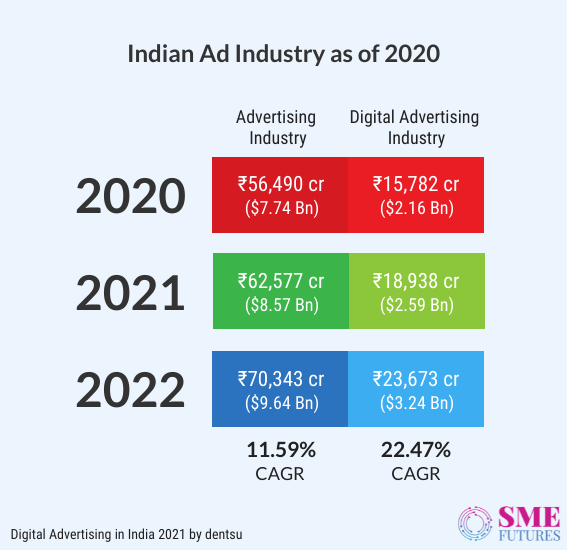It’s the year 1988, and a tea brand teamed up with famous tabla maestro Zakir Hussain to reach out to the aspirational middle class. Yes, we are talking about Brooke Bond Taj. Ever since then, Taj Tea has taken the route of celebrity endorsements, getting popular faces like Zeenat Aman and now Nirali Kartik. The question is what is the scope of advertising, well currently Taj Tea is associated with royalty and has become a premium product.
This is what advertising does to your brand, however over the years the nature of advertising has changed. It has become more than just selling your product and service, advertising is about branding now. That is, advertising is not limited to the glitzy celebrity endorsements and high-end lifestyle. The ads now are becoming more real, with stories that resonate with the audiences.
The objective of brands now is to place themselves in the market as progressive and modern. Most of the brands are focusing on targeting millennials and Gen Z’s and hence are going an extra mile with their creative choices. In fact, several brands are taking a different approach by speaking up on social issues and trying to bring a change in the consumers’ mind.
Nature and Scope of Advertising
There’s no doubt that the nature and scope of advertising as well as the prevalence of advertisements in our society is not a coincidence. From the subway to the tiny roads, brands are constantly trying to engage with consumers at every touch point in their lives, with the hope to influence their buying decisions.
An ad can be a mix of style, creativity, and sometimes to set a cultural agenda, however, the sole purpose of advertising is branding and sales.
The attention span of consumers is now shorter than ever, so the question is how do you get your brand stand out from the rest? This is where advertising comes into the picture.
Ads are everywhere. Quite literally. In fact, it has become difficult to imagine a world without them. Even in the most unlikely locations, a brand will find their way to place themselves to grab the consumers attention. The nature and scope of advertising is like a boomerang effect, while consumers find it challenging to establish what products are actually credible, for brands it’s even more difficult to establish credibility.
In the advertising world, credibility and brand identity are synonymous with effectiveness. Brands rely on graphics, video, research and emotional appeal to create engaging ads that can effectively match the needs, interests and wants of their target audience.
Scope of Advertising Industry in India
The scope of the advertising industry in India is witnessing a steady growth and is expected to be a billion dollar business in future too/ Indian advertising industries are recovering from the pandemic slump far more quickly than was anticipated. Digital Advertising and TV Advertising are growing, according to Mediabrands’ Magna study.

The research foresees a strong comeback for conventional media that were adversely affected by the pandemic, such as print. The rebound will take longer for media types like OOH and experiential, but there is optimism that 2022 will undoubtedly be a happy year.
Many brands shifted toward purpose-driven marketing in 2021. Additionally, we witnessed businesses come up with brilliant solutions to customer issues. As a result, there has been a transition from aggressive marketing to storytellers who are also problem-solvers.
The pandemic has made the majority of people aware of the fragility of human existence and has shown corporations that showing empathy is no longer optional. Advertising will be required to more closely represent this aspect of firms. Without heart, business can not prosper.
Strong socially relevant campaigns will see a boom, predicts business strategist and marketing expert Lloyd Mathias, a former marketing chief for HP Asia, Motorola India, and PepsiCo.

Importance of Advertising Brands
Advertising is like a megaphone for businesses, helping them shout about their products and services to the world. It’s how companies tell people what they have to offer and why they should care. Imagine walking down a street filled with shops; without advertising, you might not notice the cool new gadgets, tasty snacks, or helpful services hiding behind those windows.
Advertising makes sure those businesses stand out, catching your eye with catchy slogans, colorful pictures, and exciting offers. It’s not just about selling things, though; advertising also builds trust between businesses and customers, showing that they’re reliable and worth spending money on. So, whether it’s a billboard on the highway or a catchy jingle on the radio, advertising helps businesses connect with people and keep the wheels of the economy turning.
Moment Marketing to become Mainstream
Moment marketing will spread like wildfire. Advertising and communication will need to be more in sync with current events rather than just pre-planned topics as a result.
But when using a free ride, one must exercise extreme caution.
In order to celebrate badminton champion PV Sindhu being the first Indian woman to win two Olympic gold this year, a number of companies sponsored social media advertising with her images, her name, and their logo. She’s currently suing them.
The Rise of Regionalism
One of the key themes in the upcoming years will be regionalism. People will gravitate towards themes and ideas that appeal to them when they consume more stuff that is culturally relevant or that is about where they are from or live.
In the last one to two years, a lot of brand-new regional and multilingual platforms have appeared. In 2022, it would be a great idea to test the waters with them to connect with your audience, according to Dinesh Juneja, the founder of Emporiom, a digital marketing agency. (E4M)
It’s All About How Consumers’ Perceive The Message feat. Vim Ad
The well-known dishwashing brand Vim from Hindustan Unilever got itself into a situation when its fictitious dishwashing liquid Vim Black campaign, which seemed well-intentioned and self-aware, backfired.
The product, a dishwashing liquid designed exclusively for guys, came packaged in a classy black container and included instructions on how to divide household chores. Sadly, a lot was lost in translation, and the majority of the public rejected the advertising campaign.
This campaign’s goal is to spark a mindset shift once more in a fun and non-preachy way so that household tasks can truly become democratic.

When it comes to humour, the Indian audience often misunderstands the message and satire is completely missed. This is exactly what happened with the new ad by Vim starring Milind Soman, as it was something that the audiences could not connect the brand with the message conveyed.
This is the reason most brands refrain from using humour in their ads as it can often face backlash. However, what we think is that one can always test ads and look for the consumer’s opinion, so there is nothing that Vim needs to fear.
What is the scope of digital advertising in India?
The scope of digital advertising in India was significant and had been steadily growing. Given that digital advertising is a dynamic industry, the landscape might have evolved further since then. However, here are some insights into the general trends and factors that were contributing to its growth in India:
- Rapid Internet Penetration: India has seen a massive increase in internet penetration over the years, driven by affordable smartphones and data plans. This has resulted in a vast online audience, presenting a lucrative market for digital advertisers.
- Growing E-commerce Market: The e-commerce sector in India has been booming, and companies in this space heavily rely on digital advertising to reach potential customers, driving the demand for digital ads.
- Mobile-First Nation: India is predominantly mobile-first, with a significant portion of internet users accessing the internet through their mobile devices. This trend has led to a surge in mobile advertising.
- Social Media Boom: India has one of the largest user bases for social media platforms like Facebook, Instagram, Twitter, and WhatsApp. Brands leverage these platforms for targeted advertising and to engage with their audiences.
- Digital Video Advertising: The popularity of online video content platforms like YouTube, Netflix, and Amazon Prime Video has led to a surge in digital video advertising.
- Programmatic Advertising: Programmatic advertising, which uses AI algorithms to automate ad buying, has gained traction in India, providing more efficient and targeted ad placements.
- Digital Ad Spending: Businesses in India have gradually shifted their advertising budgets from traditional media to digital platforms, indicating a positive outlook for the industry.
- Government Initiatives: The Government of India has been pushing digitalisation and technology adoption, which further supports the growth of digital advertising.
- Localised Content: India’s diverse cultural landscape demands content that caters to specific regional preferences. Digital advertising allows for better targeting of localised content, making it more effective in reaching diverse audiences.
- Data Analytics and Insights: The availability of data analytics tools and insights allows advertisers to measure the effectiveness of their campaigns and optimise them for better results.
Brands that Played Out of The Box
Red Label
Dove- Stop the Beauty Test
Google- Reunion
Facebook- More Together
Prega News- Your Second Home
Sabhyata- Redefining Celebration
FAQs Related to the Scope of Advertising
What is the scope of advertising?
In the advertising world, credibility and brand identity are synonymous with effectiveness. Brands rely on graphics, video, research and emotional appeal to create engaging ads that can effectively match the needs, interests and wants of their target audience.
What is advertising nature and scope?
Ads are everywhere. Quite literally. In fact, it has become difficult to imagine a world without them. Even in the most unlikely locations, a brand will find their way to place themselves to grab the consumers attention. Advertising is like a boomerang effect, while consumers find it challenging to establish what products are actually credible, for brands it’s even more difficult to establish credibility.
What is scope of advertising in India?
Many brands shifted toward purpose-driven marketing in 2021. Additionally, we witnessed businesses come up with brilliant solutions to customer issues. As a result, there has been a transition from aggressive marketing to storytellers who are also problem-solvers.
What is the nature of advertising
The objective of brands now is to place themselves in the market as progressive and modern. Most of the brands are focusing on targeting millennials and Gen Z’s and hence are going an extra mile with their creative choices.
What are the function and nature of advertising objectives?
Advertising objectives serve as the guiding purpose for an advertising campaign. They can be diverse, including increasing brand awareness, promoting new products, driving sales, or changing consumer perceptions. The nature of advertising objectives is goal-oriented, measurable, and tailored to the needs of the business or brand. Clear objectives help advertisers strategise, create targeted messages, and evaluate the success of their campaigns.
What is the nature of advertising research?
Advertising research is a systematic process used to gather insights into consumer behaviour, market trends, and the effectiveness of advertising campaigns. It involves collecting and analysing data to inform message creation, media selection, and audience targeting decisions. The nature of advertising research is data-driven, objective, and focused on uncovering valuable consumer insights to optimise advertising efforts.
What is the nature of advertising costs?
Advertising costs vary significantly based on media selection, campaign duration, and production expenses. The nature of advertising costs is typically an investment rather than a direct revenue-generating activity. Businesses allocate budgets to advertising to promote their products or services and achieve specific marketing objectives. Cost efficiency and effectiveness are crucial considerations in designing advertising campaigns.
What is the scope and objective of advertising?
The scope of advertising is broad, encompassing various mediums such as print, television, radio, digital platforms, and outdoor displays. Its objective is to influence consumer behaviour positively. Advertising aims to create brand awareness, stimulate demand, build brand loyalty, convey product benefits, and drive sales. Effective advertising helps companies gain a competitive edge, establish their market presence, and connect with their target audience.
What is the scope of the advertising industry in India?
The advertising industry in India is vast and dynamic, reflecting the country’s diverse market. With a large population and increasing internet penetration, digital advertising has grown significantly. Traditional advertising mediums like television, print, and outdoor advertising also hold substantial importance. As businesses across various sectors continue to invest in marketing and brand building, the advertising industry in India is expected to maintain its growth trajectory.





